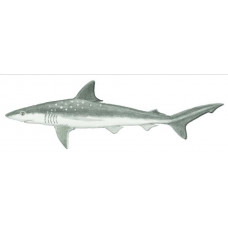Latin name
Rhizoprionodon species
Other names
Sharpnose sharks
Identification
It has a characteristic long and flattened snout and a slender brown to olive-gray body with a pale belly. The dorsal and caudal fins may have black edging, especially in young specimens, and small, scattered whitish spots are often found on the sides. The Atlantic sharpnose is characterized by well-developed grooves on the lips at the corners of the mouth and a second dorsal fin that begins above the middle of the anal fin.
Distribution
The best known member of the family is the Atlantic sharpnose (R. terraenovae), which is a very popular small species as a coastal food fish and small game fish in the Gulf of Mexico. The Atlantic sharpnose is found as far north as New Brunswick, but is rarely seen north of North Carolina. The Caribbean sharpnose (R. porosus) may be a subspecies of the Atlantic sharpnose, but is found mainly in Caribbean waters. The Pacific sharpnose (P. longurio) is quite common in the Gulf of California and is a frequent target of sharks living there, extending as far south as Peru.
Habitat
No information
Size
They grow up to 2-4 feet in length.
Life history and Behavior
No information
Food and feeding habits
No information
Reproduction
No information
| Classification | |
| Phylum | Chordata |
| Class | Chondrichthyes |
| Squad | Carcharhiniformes |
| Family | Carcharhinidae |
| Genus | Rhizoprionodon |
| Species | R. terraenovae |
| Features | |
| Conservation status | Least Concern |
| Habitat | Littoral |
| Life span, years | 12 |
| Maximum body weight, kg | No information |
| Maximum length, cm | 120 |
| Sailing speed, m/s | No information |
| Threat to people | Edible |
| Way of eating | Predator |

